一般过去时语法讲解
一般过去时的语法
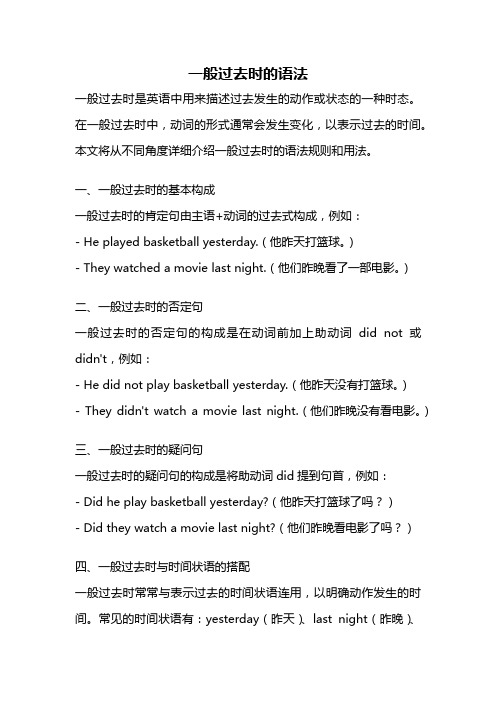
一般过去时的语法一般过去时是英语中用来描述过去发生的动作或状态的一种时态。
在一般过去时中,动词的形式通常会发生变化,以表示过去的时间。
本文将从不同角度详细介绍一般过去时的语法规则和用法。
一、一般过去时的基本构成一般过去时的肯定句由主语+动词的过去式构成,例如:- He played basketball yesterday.(他昨天打篮球。
)- They watched a movie last night.(他们昨晚看了一部电影。
)二、一般过去时的否定句一般过去时的否定句的构成是在动词前加上助动词did not或didn't,例如:- He did not play basketball yesterday.(他昨天没有打篮球。
)- They didn't watch a movie last night.(他们昨晚没有看电影。
)三、一般过去时的疑问句一般过去时的疑问句的构成是将助动词did提到句首,例如:- Did he play basketball yesterday?(他昨天打篮球了吗?)- Did they watch a movie last night?(他们昨晚看电影了吗?)四、一般过去时与时间状语的搭配一般过去时常常与表示过去的时间状语连用,以明确动作发生的时间。
常见的时间状语有:yesterday(昨天)、last night(昨晚)、last week(上周)、in 2010(在2010年)等等。
五、一般过去时的用法1. 表示过去发生的动作或状态She lived in New York for five years.(她在纽约住了五年。
)2. 表示过去经常或反复发生的动作He often went swimming when he was young.(他年轻时经常去游泳。
)3. 表示过去的习惯或常态She always cooked dinner for her family.(她过去总是为家人做晚饭。
英语语法--一般过去时讲解与练习
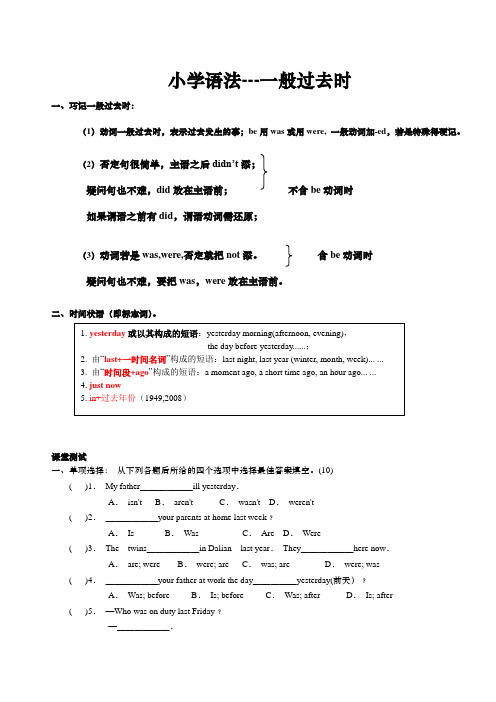
小学语法---一般过去时一、巧记一般过去时:(1)动词一般过去时,表示过去发生的事;be用was或用were, 一般动词加-ed,若是特殊得硬记。
(2)否定句很简单,主语之后didn’t添;疑问句也不难,did放在主语前;不含be动词时如果谓语之前有did,谓语动词需还原;(3)动词若是was,were,否定就把not添。
含be动词时疑问句也不难,要把was,were放在主语前。
二、时间状语(即标志词)。
1.yesterday或以其构成的短语:yesterday morning(afternoon, evening),the day before yesterday......;2. 由“last+一时间名词”构成的短语:last night, last year (winter, month, week)... ...3. 由“时间段+ago”构成的短语:a moment ago, a short time ago, an hour ago... ...4. just now5. in+过去年份(1949,2008)课堂测试一、单项选择:从下列各题后所给的四个选项中选择最佳答案填空。
(10)( )1.My father______ill yesterday.A.isn't B.aren't C.wasn't D.weren't( )2.______your parents at home last week﹖A.Is B.Was C.Are D.Were( )3.The twins______in Dalian last year.They______here now.A.are; were B.were; are C.was; are D.were; was ( )4.______your father at work the day_____yesterday(前天)﹖A.Was; before B.Is; before C.Was; after D.Is; after ( )5.—Who was on duty last Friday﹖—______.A.I am B.I was C.Yes, I was D.No, I wasn't ( )6. I cleaned my classroom ___________.A with three hoursB three hours agoC in three hoursD three hours before( ) 7. I came _______ my house two days ago .A back onB back toC to backD back( ) 8 . ___________? He did some reading at home.A What does your father do yesterday eveningB What does your brother do in the schoolC What did your brother do over the weekendD Where did your brother go last Sunday二、请用正确动词形式填空。
英语一般过去时语法知识讲解
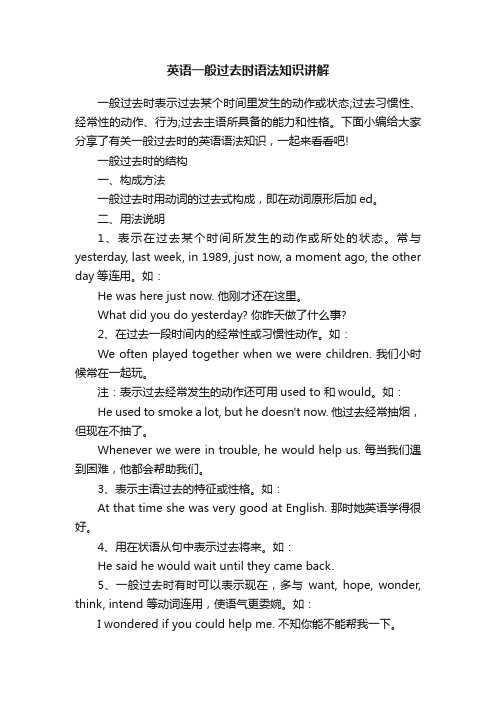
英语一般过去时语法知识讲解一般过去时表示过去某个时间里发生的动作或状态;过去习惯性、经常性的动作、行为;过去主语所具备的能力和性格。
下面小编给大家分享了有关一般过去时的英语语法知识,一起来看看吧!一般过去时的结构一、构成方法一般过去时用动词的过去式构成,即在动词原形后加ed。
二、用法说明1、表示在过去某个时间所发生的动作或所处的状态。
常与yesterday, last week, in 1989, just now, a moment ago, the other day等连用。
如:He was here just now. 他刚才还在这里。
What did you do yesterday? 你昨天做了什么事?2、在过去一段时间内的经常性或习惯性动作。
如:We often played together when we were children. 我们小时候常在一起玩。
注:表示过去经常发生的动作还可用used to 和would。
如:He used to smoke a lot, but he doesn't now. 他过去经常抽烟,但现在不抽了。
Whenever we were in trouble, he would help us. 每当我们遇到困难,他都会帮助我们。
3、表示主语过去的特征或性格。
如:At that time she was very good at English. 那时她英语学得很好。
4、用在状语从句中表示过去将来。
如:He said he would wait until they came back.5、一般过去时有时可以表示现在,多与want, hope, wonder, think, intend 等动词连用,使语气更委婉。
如:I wondered if you could help me. 不知你能不能帮我一下。
6、有时用一般过去时也是时态一致的需要。
2025届高考英语语法复习一般过去时知识讲解讲义
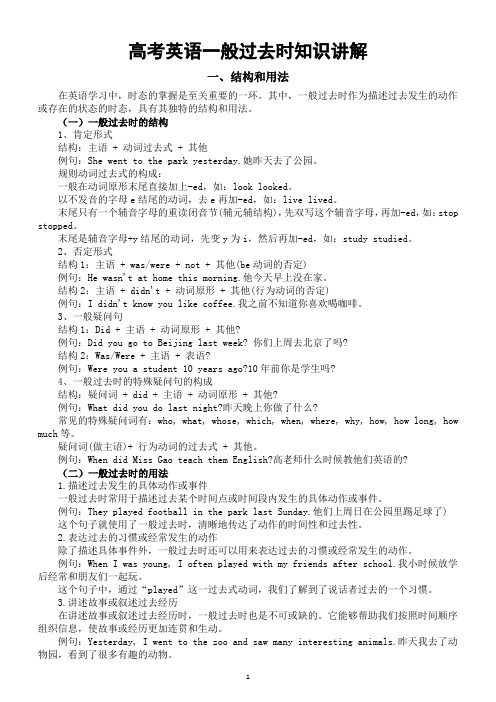
高考英语一般过去时知识讲解一、结构和用法在英语学习中,时态的掌握是至关重要的一环。
其中,一般过去时作为描述过去发生的动作或存在的状态的时态,具有其独特的结构和用法。
(一)一般过去时的结构1、肯定形式结构:主语 + 动词过去式 + 其他例句:She went to the park yesterday.她昨天去了公园。
规则动词过去式的构成:一般在动词原形末尾直接加上-ed,如:look looked。
以不发音的字母e结尾的动词,去e再加-ed,如:live lived。
末尾只有一个辅音字母的重读闭音节(辅元辅结构),先双写这个辅音字母,再加-ed,如:stop stopped。
末尾是辅音字母+y结尾的动词,先变y为i,然后再加-ed,如:study studied。
2、否定形式结构1:主语 + was/were + not + 其他(be动词的否定)例句:He wasn't at home this morning.他今天早上没在家。
结构2:主语 + didn't + 动词原形 + 其他(行为动词的否定)例句:I didn't know you like coffee.我之前不知道你喜欢喝咖啡。
3、一般疑问句结构1:Did + 主语 + 动词原形 + 其他?例句:Did you go to Beijing last week? 你们上周去北京了吗?结构2:Was/Were + 主语 + 表语?例句:Were you a student 10 years ago?10年前你是学生吗?4、一般过去时的特殊疑问句的构成结构:疑问词 + did + 主语 + 动词原形 + 其他?例句:What did you do last night?昨天晚上你做了什么?常见的特殊疑问词有:who, what, whose, which, when, where, why, how, how long, how much等。
高中英语语法一般过去时详细讲解
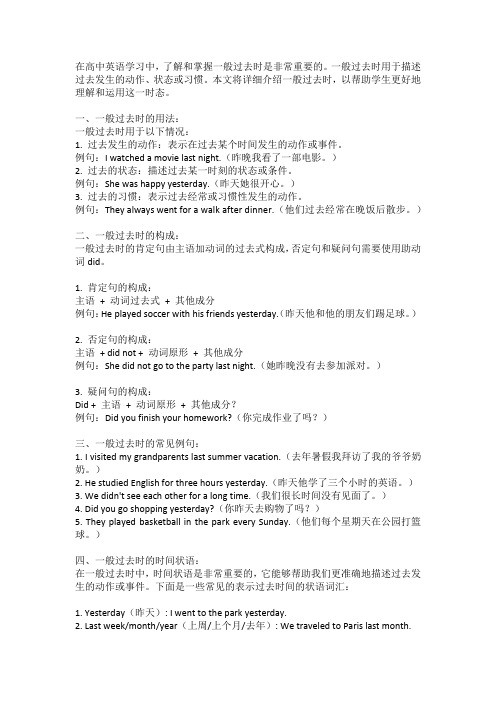
在高中英语学习中,了解和掌握一般过去时是非常重要的。
一般过去时用于描述过去发生的动作、状态或习惯。
本文将详细介绍一般过去时,以帮助学生更好地理解和运用这一时态。
一、一般过去时的用法:一般过去时用于以下情况:1. 过去发生的动作:表示在过去某个时间发生的动作或事件。
例句:I watched a movie last night.(昨晚我看了一部电影。
)2. 过去的状态:描述过去某一时刻的状态或条件。
例句:She was happy yesterday.(昨天她很开心。
)3. 过去的习惯:表示过去经常或习惯性发生的动作。
例句:They always went for a walk after dinner.(他们过去经常在晚饭后散步。
)二、一般过去时的构成:一般过去时的肯定句由主语加动词的过去式构成,否定句和疑问句需要使用助动词did。
1. 肯定句的构成:主语+ 动词过去式+ 其他成分例句:He played soccer with his friends yesterday.(昨天他和他的朋友们踢足球。
)2. 否定句的构成:主语+ did not + 动词原形+ 其他成分例句:She did not go to the party last night.(她昨晚没有去参加派对。
)3. 疑问句的构成:Did + 主语+ 动词原形+ 其他成分?例句:Did you finish your homework?(你完成作业了吗?)三、一般过去时的常见例句:1. I visited my grandparents last summer vacation.(去年暑假我拜访了我的爷爷奶奶。
)2. He studied English for three hours yesterday.(昨天他学了三个小时的英语。
)3. We didn't see each other for a long time.(我们很长时间没有见面了。
初中英语一般过去时语法讲解

III.一般过去时1.一般过去时表示过去某个时间里发生的动作或状态;过去习惯性、经常性的动作、行为;过去主语所具备的能力和性格。
2.一般过去时,表示过去某个时间里发生的非持续性动作或存在的状态,也表示经常或反复发生的动作。
3.动词的变化1).直接加ed:work——worked look——looked talked visited2).以不发音e结尾的单词,直接加d:live ——lived hope——hoped use——used arrived3).以辅音字母+y结尾的,变y为i加ed:study——studied carry——carried worry——worried4).以重读闭音节结尾的,双写最后的辅音字母+ed:stop——stopped plan——plannedShop--shopped读音:清辅音后读/t/,浊辅音读/d/,在/t/和/d/后读/id/.5). 不规则变化的动词过去式:have---had are---were get---got say---said feel---felt do/does---did is---wasgo---wentdrink--drank eat--ate bring----brought think----thought buy----bought catch---- caught teach ---- taught sit----sat wear----wore cut----cut sweep----swept sleep——slept become----became4.常跟过去时间状语连用yesterday (morning,afternoon,evening)the day before yesterdaylast night (week,Sunday,weekend,month,winter,year,century 世纪)a year agothis morning/afternoon/eveningwhen引导的状语从句(动词过去时)just nowthe other day -- a few days ago.at the age of 10 (过去年龄段)in the old daysat that timeat that moment在那一刻例如:Li Ming did the dishes just now.She took the Subway to school this morning.My grandpa was dead last year.二、句法结构基本结构:主语+谓语(动词过去式)+句子其他成分;主语+was/were+形容词/名词/介词短语+过去时间;否定形式①was/were+not;②在行为动词前加didn't,同时还原行为动词;一般疑问句Did+主语+do+其他1、肯定形式主语+动词过去式+其他例句:She often came to help us in those days.2、否定形式①was/were+not;②在行为动词前加didn't,同时还原行为动词例句:I didn't know you like coffee.3、一般疑问句①Did+主语+谓语动词原型+其他?②Was\Were+主语+表语?例句:Did +任何人称+do homework?肯定回答:Yes,代词+did.No,代词+didn’t三、口诀一般过去时并不难,过去动作、状态记心间。
过去式语法

姓名:_________________ 家长签字:______________Grammar time(语法知识)——一般过去时【1】概念:一般过去时表示过去某个时间发生的动作或存在的状态,常和表示过去的时间状语连用。
一般过去时也表示过去经常或反复发生的动作。
【2】时间状语:just now(刚才), ……ago(……以前), last……(上个……), yesterday(昨天) ,the day before yesterday(前天), this morning等。
【3】Be动词在一般过去时中的变化:⑴am 和is在一般过去时中变为was。
(was not=wasn’t)⑵are在一般过去时中变为were。
(were not=weren’t)⑶带有was或were的句子,其否定、疑问的变化和is, am, are一样,即否定句在was或were后加not,一般疑问句把was或were调到句首。
例句:The king was happy.否定句:The king was not happy.一般疑问句:Was the king happy例句:There were a lot of people in the street.否定句:There were not a lot of people in the street.一般疑问句:Were there a lot of people in the street【4】句中没有be动词的一般过去时的句子否定句:didn’t +动词原形例句:Jim went home yesterday.(变为否定句)→Jim didn’t go home yesterday. (went还原为go,因为didn’t 也是助动词,而助动词后面动词用原形)一般疑问句:在句首加did,句子中的动词过去式变回原形。
例句:Jim went home yesterday.(改为一般疑问句)→ Did Jim go home yesterday特殊疑问句:⑴特殊疑问词+did+主语+动词原形如:What did Jim do yesterday 吉姆昨天干什么的⑵疑问词当主语时:疑问词+动词过去式如:Who went to home yesterday【5】动词过去式变化规则:1.一般情况下在动词词尾直接加-ed,如:point--pointed;laugh--laughed2.以“e”结尾的动词,加d,如:like--liked3.末尾只有一个元音字母和一个辅音字母的重读闭音节,应双写末尾的辅音字母,再加-ed,如:stop-stopped4.以“辅音字母+y”结尾的动词,变y为i,再加-ed,如:study-studied5.不规则动词过去式:am,is-was, are-were, do-did, see-saw, say-said, give-gave, get-got, go-went, come-came, have-had, eat-ate, take-took, run-ran, sing-sang, put-put, make-made, read-read, write-wrote, draw-drew, drink-drank, fly-flew, ride-rode, speak-spoke, sweep-swept, swim-swam, sit-sat【语法】牢记四个四,学好过去时★★★★★一般过去时表示在过去某个时间发生的动作或存在的状态,常与表示过去的时间短语连用。
语法部分(二)一般过去时
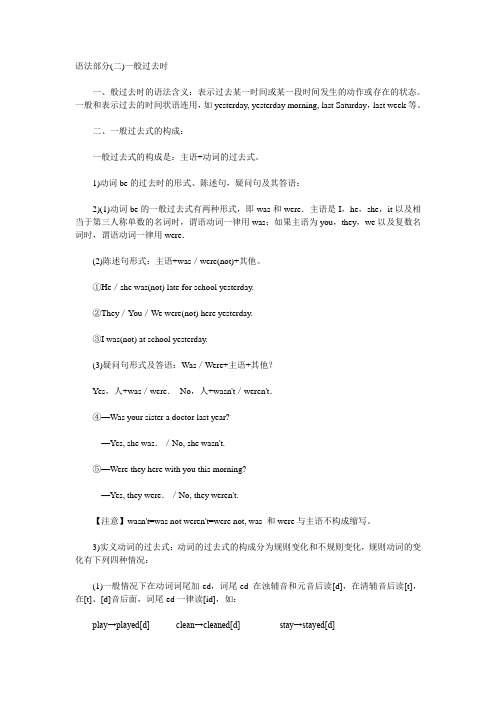
语法部分(二)一般过去时一、般过去时的语法含义:表示过去某一时间或某一段时间发生的动作或存在的状态。
一般和表示过去的时间状语连用,如yesterday, yesterday morning, last Saturday,last week等。
二、一般过去式的构成:一般过去式的构成是:主语+动词的过去式。
1)动词be的过去时的形式、陈述句,疑问句及其答语:2)(1)动词be的一般过去式有两种形式,即was和were.主语是I,he,she,it以及相当于第三人称单数的名词时,谓语动词一律用was;如果主语为you,they,we以及复数名词时,谓语动词一律用were.(2)陈述句形式:主语+was/were(not)+其他。
①He/she was(not) late for school yesterday.②They/You/We were(not) here yesterday.③I was(not) at school yesterday.(3)疑问句形式及答语:Was/Were+主语+其他?Yes,人+was/were.No,人+wasn't/weren't.④—Was your sister a doctor last year?—Yes, she was./No, she wasn't.⑤—Were they here with you this morning?—Yes, they were./No, they weren't.【注意】wasn't=was not weren't=were not, was 和were与主语不构成缩写。
3)实义动词的过去式:动词的过去式的构成分为规则变化和不规则变化,规则动词的变化有下列四种情况:(1)一般情况下在动词词尾加-ed,词尾-ed在浊辅音和元音后读[d],在清辅音后读[t],在[t]、[d]音后面,词尾-ed一律读[id],如:play→played[d]clean→cleaned[d] stay→stayed[d]ask→asked [t] cook→cooked [t] watch→watched[t]need→needed[id]want→wa nted[id] visit→visited[id](2)词尾是e的动词加-d。
英语学习:一般过去时语法解释大全
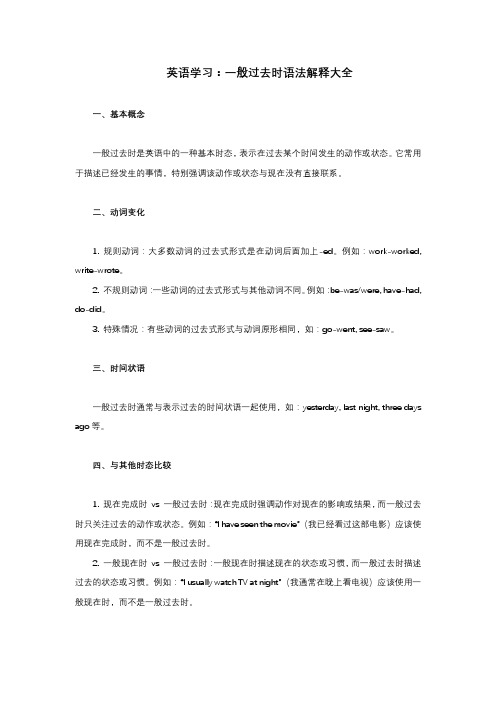
英语学习:一般过去时语法解释大全一、基本概念一般过去时是英语中的一种基本时态,表示在过去某个时间发生的动作或状态。
它常用于描述已经发生的事情,特别强调该动作或状态与现在没有直接联系。
二、动词变化1. 规则动词:大多数动词的过去式形式是在动词后面加上-ed。
例如:work-worked, write-wrote。
2. 不规则动词:一些动词的过去式形式与其他动词不同。
例如:be-was/were, have-had, do-did。
3. 特殊情况:有些动词的过去式形式与动词原形相同,如:go-went, see-saw。
三、时间状语一般过去时通常与表示过去的时间状语一起使用,如:yesterday, last night, three days ago等。
四、与其他时态比较1. 现在完成时vs 一般过去时:现在完成时强调动作对现在的影响或结果,而一般过去时只关注过去的动作或状态。
例如:“I have seen the movie”(我已经看过这部电影)应该使用现在完成时,而不是一般过去时。
2. 一般现在时vs 一般过去时:一般现在时描述现在的状态或习惯,而一般过去时描述过去的状态或习惯。
例如:“I usually watch TV at night”(我通常在晚上看电视)应该使用一般现在时,而不是一般过去时。
五、特殊用法1. 表达过去的经验:例如:“I visited Paris last year”(我去年参观了巴黎)。
2. 表达假设条件:例如:“If I were you, I would do it”(如果我是你,我会去做这件事)。
六、与过去进行时的区别1. 时间焦点:过去进行时强调在过去某一段时间正在发生的动作,而一般过去时描述过去的某个时间点发生的动作。
2. 语态选择:过去进行时用于描述过去某个时刻正在进行的动作,通常使用进行体(was/were+动词ing形式),而一般过去时则直接使用动词的过去式形式。
小学英语 语法详解- 02.一般过去时

英语一般过去时定义表示在的过去某个时间里所发生的动作或存在的状态。
构成一般过去时的句式变化1.陈述句:主语+动词过去式+其他I saw the rianbow yesterday.我昨天看到了彩虹。
They went to he park last Sunday.上周日他们去了公园。
Ben got up at six this morning.本今天早上是六点起床的。
2.一般疑问句1)将be动词提到句首陈述句:It was an egg yesterday.它昨天还是一个蛋。
一般疑问句:Was it an egg yesterday?它昨天还是一个蛋吗?陈述句:They were at school just now.他们刚才还在学校。
一般疑问句:Were they at school just now?他们刚才还在学校吗?Linda老师的小提醒主语是第一人称和第二人称的句子,其过去时变化时,要注意be动词的变化。
一般疑问句:Were you at home last night?你昨天晚上在家吗?肯定回答:Yes,I was.否定回答:No,I wasn't.2)用助动词did陈述句:I did my homework at school,我在学校做了作业。
一般疑问句:Did you do your homework at school?你在学校做作业了吗?陈述句:They played basketball just now.他们刚才打了篮球。
一般疑问句:Did they play basketball just now?他们刚才打篮球了吗?小提醒由过去时态的陈述句变一般疑问句时,变化技巧上可以用拆分法,将动词过去式拆分为did+动词原形,然后将did提到句首,这样就不容易发生错误。
He slept a whole day.他睡了一整天。
第一步:先将slept拆分为did sleep第二步:将did提到句首变成:Did he sleep a whole day?他睡了一整天吗?3.否定句1)在be动词后面+not陈述句:I was a teacher twenty years ago.我20年前是一名老师。
一般过去时讲解

05
一般过去时的注意事项
避免与现在完成时的混淆
01
区别动作发生的时间点
一般过去时表示过去某个时间发生的动作或存在的状态,而现在完成时
强调的是动作从过去一直持续到现在,可能还会持续下去。
02 03
注意时间状语的运用
一般过去时通常与表示过去的时间状语连用,如yesterday、last year 等,而现在完成时则常与表示现在的时间状语连用,如so far、up to now等。
在描述历史事实中的应用
描述历史事件,例如“The Declaration of Independence was signed in 1776”(《独立宣言》于 1776年签署)。
描述历史人物的行为或遭遇,例如“Napoleon Bonaparte conquered much of Europe in the early 19th century”(拿破仑·波拿巴在19世纪初征服了欧洲的大部分地区)。
一般过去时讲解
目录
• 一般过去时的定义 • 一般过去时的动词变化 • 一般过去时的句型结构 • 一般过去时的语境应用 • 一般过去时的注意事项
01
一般过去时的定义
什么是一般过去时
01
一种描述过去发生的动作或状态 的时态。
02
表示过去某个时间点、某段时间 或某个情境下的动作或状态。
一般过去时的语法形式
动词时态的一致性
在描述一系列动作时,应注意保持动词时态的一致性,避免混淆。
注意时间状语的使用
准确运用时间状语
使用一般过去时需要准确选择和运用 时间状语,如使用ago表示过去的某 个时间点,使用just now表示刚刚发 生的动作。
避免使用模糊的时间状语
一般过去时-语法
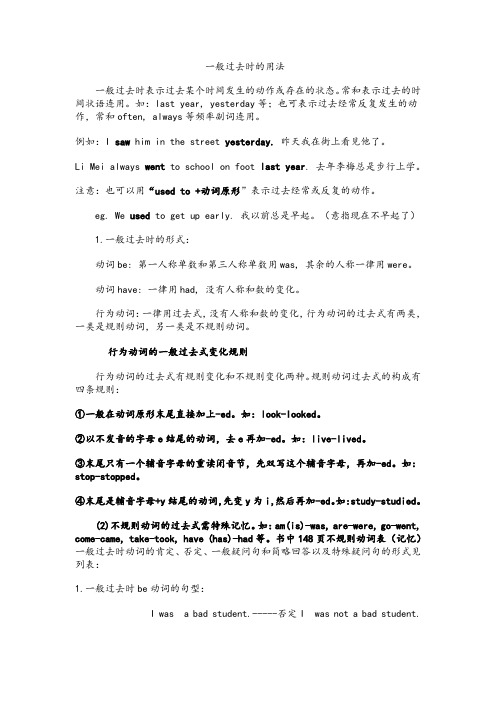
一般过去时的用法一般过去时表示过去某个时间发生的动作或存在的状态。
常和表示过去的时间状语连用。
如:last year, yesterday等;也可表示过去经常反复发生的动作,常和often, always等频率副词连用。
例如:I saw him in the street yesterday. 昨天我在街上看见他了。
Li Mei always went to school on foot last year. 去年李梅总是步行上学。
注意:也可以用“used to +动词原形”表示过去经常或反复的动作。
eg. We used to get up early. 我以前总是早起。
(意指现在不早起了)1.一般过去时的形式:动词be: 第一人称单数和第三人称单数用was, 其余的人称一律用were。
动词have: 一律用had, 没有人称和数的变化。
行为动词:一律用过去式,没有人称和数的变化,行为动词的过去式有两类,一类是规则动词,另一类是不规则动词。
行为动词的一般过去式变化规则行为动词的过去式有规则变化和不规则变化两种。
规则动词过去式的构成有四条规则:①一般在动词原形末尾直接加上-ed。
如:look-looked。
②以不发音的字母e结尾的动词,去e再加-ed。
如:live-lived。
③末尾只有一个辅音字母的重读闭音节,先双写这个辅音字母,再加-ed。
如:stop-stopped。
④末尾是辅音字母+y结尾的动词,先变y为i,然后再加-ed。
如:study-studied。
(2)不规则动词的过去式需特殊记忆。
如:am(is)-was, are-were, go-went, come-came, take-took, have (has)-had等。
书中148页不规则动词表(记忆)一般过去时动词的肯定、否定、一般疑问句和简略回答以及特殊疑问句的形式见列表:1.一般过去时be动词的句型:I was a bad student.-----否定I was not a bad student.He was a bad student----- 否定 he was not a bad studentYou were a bad student------ you were not a bad student.Be 动词的一般疑问:I was a bad student.-----疑问Were you a bad student?He was a bad student----- 疑问 Was he a bad student?You were a bad student------疑问Were you a bad student.?答语:yes, I was /No, I was not2.一般过去时行为动词的几种句型肯定句结构为:主语+动词的过去式+其他。
一般过去时态语法总结

一般过去时I. 一般过去时的概念一般过去时表示过去某个时间发生的动作或存在的状态。
常和表示过去的时间状语连用。
如:last year, yesterday, last week, three years ago, in 1978, a moment ago, just now等;也可表示过去经常反复发生的动作,常和often, always等频率副词连用。
例如:①I saw him in the street yesterday. 昨天我在街上看见他了。
②Li Mei always went to school on foot last year. 去年李梅总是步行上学II. 一般过去时的几种句型be动词过去式的句式。
否定句是在was/were后面加not,was not (wasn't)/were not (weren't)。
一般疑问句是把was / were提前并放到句首,要求首字母要大写。
实义动词过去式的句式。
肯定句结构为:主语+动词的过去式+其它。
如:He went to the toy store yesterday. 他昨天去玩具店了。
否定句结构为:主语+did not (didn’t)+动词原形+其它。
如:He didn’t go to the toy store yesterday. 他昨天没去玩具店。
一般过去时的一般疑问句的构成:Did+主语+动词原形+其它?如:1) -Did you go to Beijing last week?-Yes, we did. (No, we didn’t.)2) -Did you meet the businessman before?-No, I didn’t. (Yes, I did.)一般过去时的特殊疑问句的构成:疑问词+did+主语+动词原形+其它?如:1) -What did you do last night?-I did my homework.2) -Where did you go last week?-I went to Shanghai with my parents.。
一般过去时语法讲解

Infinitive catch come do draw drink drive eat fall
Past tense caught came did drew drank drove ate fell
8
Please look at the sentences
我今年12岁. I _a_m_ 12 years old this year.
morning
yesterday afternoon
evening
2020/11/30 the day before yesterday
16
4.与one 连用: morning
one
evening day
Monday afternoon
5.与that 连用:
that
morning winter day year
2020/11/30
雷锋同志做了一生的好事。
4. 表示过去所发生的一系列的动作,而这一系列 的动作是从现在的角度来考虑的,不是从动作相互 之间的关系这一角度来考虑的。
Miss Liu got up at seven o’clock this morning, dressed, had breakfast, and went to work.
Was the air clean yesterday? 肯定回答:Yes, it was. 否定回答:No, it wasn't. 特殊疑问句:How was the air yesterday?
2020/11/30
24
2. 行为动词(v.)的一般过去时态
(1)肯定句式:主语 + v-ed+ 其它+时间状语 .
1.与ago 连用: a moment two minutes three hours five days one week six months four years
一般过去时语法总结归纳
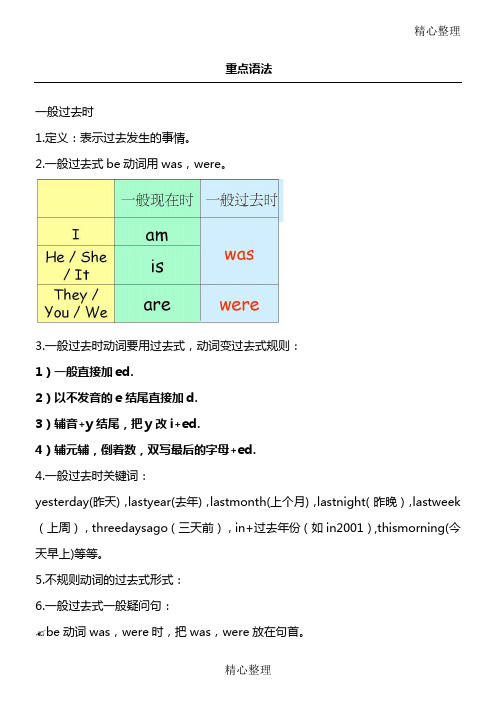
精心整理
重点语法
一般过去时
1.定义:表示过去发生的事情。
2.一般过去式be动词用was,were。
3.一般过去时动词要用过去式,动词变过去式规则:
1)一般直接加ed.
2)以不发音的e结尾直接加d.
3)辅音+y结尾,把y改i+ed.
4)辅元辅,倒着数,双写最后的字母+ed.
4.一般过去时关键词:
yesterday(昨天),lastyear(去年),lastmonth(上个月),lastnight(昨晚),lastweek (上周),threedaysago(三天前),in+过去年份(如in2001),thismorning(今天早上)等等。
5.不规则动词的过去式形式:
6.一般过去式一般疑问句:
be动词was,were时,把was,were放在句首。
精心整理
精心整理
精心整理
Wasthereany+可数名词单数或不可数名词....?
Yes,therewas./No,therewasn ’t.
Werethereany+可数名词复数.....?
Yes,therewere./No,thereweren ’t.
有动词时变一般疑问句,把Did 放句首,动词恢复原形。
Did+主语+动词原形....?
7.。
小学英语一般过去时语法详解
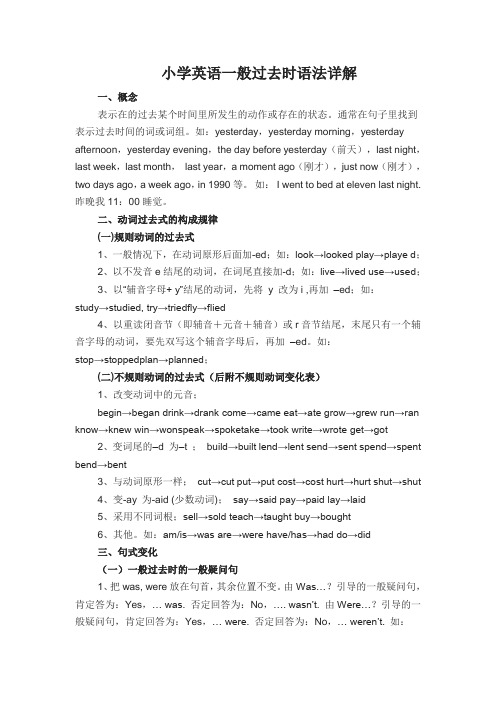
小学英语一般过去时语法详解一、概念表示在的过去某个时间里所发生的动作或存在的状态。
通常在句子里找到表示过去时间的词或词组。
如:yesterday,yesterday morning,yesterday afternoon,yesterday evening,the day before yesterday(前天),last night,last week,last month,last year,a moment ago(刚才),just now(刚才),two days ago,a week ago,in 1990等。
如:I went to bed at eleven last night.昨晚我11:00睡觉。
二、动词过去式的构成规律(一)规则动词的过去式1、一般情况下,在动词原形后面加-ed;如:look→looked play→playe d;2、以不发音e结尾的动词,在词尾直接加-d;如:live→lived use→used;3、以“辅音字母+ y”结尾的动词,先将y 改为i ,再加–ed;如:study→studied, try→triedfly→flied4、以重读闭音节(即辅音+元音+辅音)或r音节结尾,末尾只有一个辅音字母的动词,要先双写这个辅音字母后,再加–ed。
如:stop→stoppedplan→planned;(二)不规则动词的过去式(后附不规则动词变化表)1、改变动词中的元音;begin→began drink→drank come→came eat→ate grow→grew run→ran know→knew win→wonspeak→spoketake→took write→wrote get→got2、变词尾的–d 为–t ;bu ild→built lend→lent send→sent spend→spent bend→bent3、与动词原形一样;cut→cut put→put cost→cost hurt→hurt shut→shut4、变-ay 为-aid (少数动词);say→said pay→paid lay→laid5、采用不同词根;sell→sold teach→taught buy→bought6、其他。
- 1、下载文档前请自行甄别文档内容的完整性,平台不提供额外的编辑、内容补充、找答案等附加服务。
- 2、"仅部分预览"的文档,不可在线预览部分如存在完整性等问题,可反馈申请退款(可完整预览的文档不适用该条件!)。
- 3、如文档侵犯您的权益,请联系客服反馈,我们会尽快为您处理(人工客服工作时间:9:00-18:30)。
一般过去时语法讲解
How was your school trip?
语法讲解——一般过去时
教材分析:
本单元以学校旅行为主题,以同学间谈论各自的游览经历为背景,展开多种形式的语
言训练活动,目的是让学生逐步学会运用一般过去时态叙述和询问过去的活动经历。
为了
让学生对过去时这种时态有初步了解,所以在本单元的第一课时安排了一般过去时语法讲解,让学生对一般过去时的基本用法、基本句子结构以及如何使用进行初步的了解、掌握。
学情分析:
学生在小学阶段对过去式曾有过粗浅的认识,但对过去时的认知缺乏理论,不够系统,在初中学生认知能力提高的基础上,通过第一课时语法知识点的引导,达到清楚对过去时
基本用法、能够对过去时基本句子结构进行转换、进行简单描述的目的。
教学目标和教学内容:
了解一般过去时的使用、结构及句型转换
教学重难点:
1.be动词和实义动词(规则性动词)过去式的变化
2.一般过去时特殊疑问句、一般疑问句的运用以及掌握
Teaching Procedure:
I Leading in
Greeting
II Step1
What day is it today? It is Monday today.
What day is it yesterday? It was Sunday today.
How is the weather today? It is…..
How was the weather yesterday? It was….
How are you today? I am ……
How are you yesterday? You were…….
1. Read these sentences
2. 引入一般过去时概念, (he/she/it) is-was
(they/we/you ) are-were
Step2
What did I do yesterday ?
washed my clothes
cleaned my room
yesterday
visited my friend
planted some flowers 1. Read these sentences
2. Ask and answer T: What did I do yesterday ?
S1: You …….
S2: You …….
3. P63 参照课本,总结规则性动词的变化
Step3 (Report)
T:I did so many things yesterday, now, I want to know What did you do last weekend ?Talk about What did you do last weekend in your group, and I will ask No.1 to show us.(小组内讨论,谁在上周末做了什么,由1号整理并汇报,1号汇报时其他同学进行记录)
1. 师生问答(师生根据1号汇报情况进行问答)
2. 两人组学生问答(学生根据1号汇报情况进行问答)
T: Did she/he…….?
S: Yes, she/he did. No, she/he did n’t. she/he……
III Summary
1. (he/she/it) is-was
(they/we/you ) are-were
2. What did I do yesterday ? I………
3. T: Did she/he…….?
S: Yes, she/he did./No, she/he didn’t. she/he…… IIIV Test
1. Show 6 pictures and read the phrases about times
2. The students complete the dialogue
V Homework
My family’s weekend。
